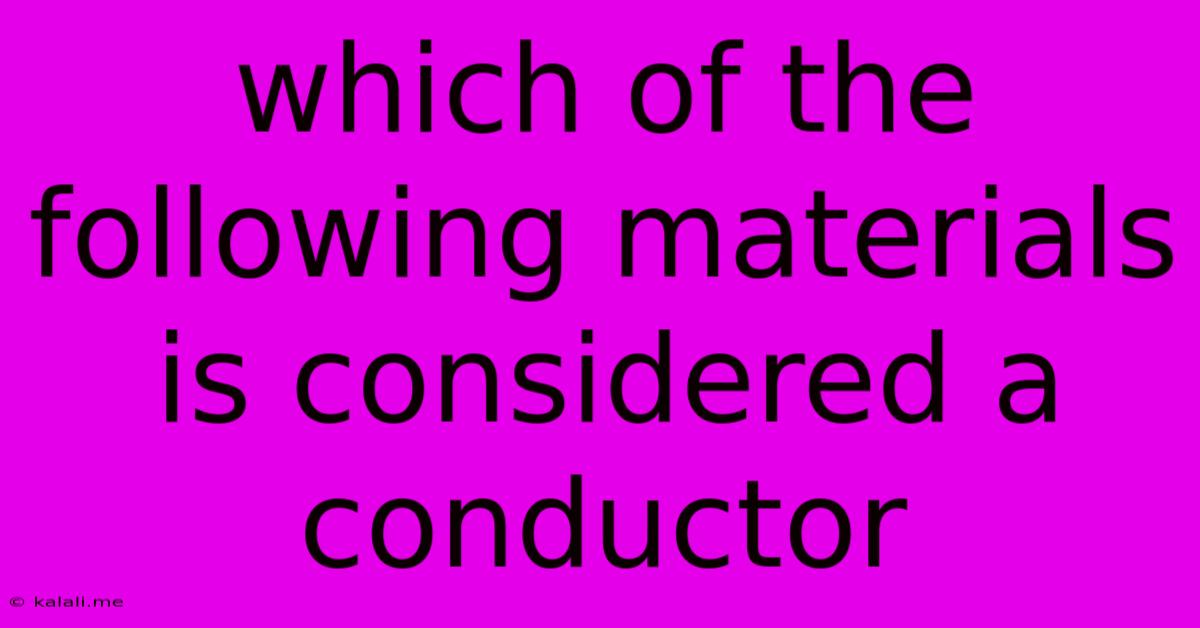Which Of The Following Materials Is Considered A Conductor
Kalali
Jun 15, 2025 · 2 min read

Table of Contents
Which of the Following Materials is Considered a Conductor? Understanding Electrical Conductivity
This article will explore the concept of electrical conductivity and help you identify which materials are classified as conductors. Understanding conductivity is crucial in various fields, from electrical engineering and electronics to material science. We'll delve into the properties that determine a material's conductive ability and provide examples of common conductors and insulators.
What is Electrical Conductivity?
Electrical conductivity refers to a material's ability to allow the flow of electric charge. This flow is facilitated by the movement of electrons, the negatively charged particles within atoms. Materials with high conductivity allow electrons to move freely, while materials with low conductivity restrict electron flow. This ability is directly related to a material's atomic structure and the availability of free electrons.
Factors Affecting Conductivity:
Several factors influence a material's electrical conductivity:
- Atomic Structure: Materials with loosely bound outer electrons (valence electrons) tend to be better conductors. These electrons can easily detach from their atoms and move freely within the material, carrying electric current.
- Temperature: Generally, the conductivity of metals decreases with increasing temperature. Increased thermal energy causes more atomic vibrations, hindering the free movement of electrons.
- Impurities: The presence of impurities in a material can significantly affect its conductivity. Impurities can act as scattering centers, disrupting the flow of electrons and reducing conductivity.
- Material Type: Different materials possess vastly different conductivity levels. Metals are typically excellent conductors, while non-metals are generally insulators.
Conductors vs. Insulators:
The key distinction lies in the ease with which electrons can move:
-
Conductors: Materials with high electrical conductivity. Electrons move freely. Examples include: copper, aluminum, gold, silver, and other metals. These materials are widely used in electrical wiring and circuitry.
-
Insulators: Materials with very low electrical conductivity. Electrons are tightly bound to their atoms and cannot move easily. Examples include: rubber, plastic, glass, wood, and air. These materials are used to prevent the flow of electricity.
-
Semiconductors: These materials have intermediate conductivity, falling between conductors and insulators. Their conductivity can be controlled by various factors, such as temperature or the addition of impurities (doping). Silicon and germanium are common examples, crucial in electronics and computer chips.
Identifying Conductors from a List:
When given a list of materials, you need to consider their atomic structure and typical properties. Look for metals, as they are the best conductors. Materials like rubber, plastic, or wood are insulators. If you encounter materials like silicon or germanium, remember they are semiconductors, exhibiting properties of both conductors and insulators depending on the conditions.
In summary: Identifying a conductor involves understanding the fundamental principles of electrical conductivity, the atomic structure of the material, and its typical properties. Metals, with their loosely bound electrons, consistently demonstrate high conductivity, while non-metals generally act as insulators. Semiconductors, meanwhile, represent a unique class of materials with controllable conductivity. Understanding these differences is fundamental to many areas of science and technology.
Latest Posts
Latest Posts
-
Which Of These Elements Has The Smallest Atomic Radius
Jun 15, 2025
-
What Is Permanent Split Capacitor Motor
Jun 15, 2025
-
What Is The Value Of P Apex
Jun 15, 2025
-
Control Rods In A Nuclear Reactor Are Used To
Jun 15, 2025
-
What Reagent Can Affect The Following Transformation
Jun 15, 2025
Related Post
Thank you for visiting our website which covers about Which Of The Following Materials Is Considered A Conductor . We hope the information provided has been useful to you. Feel free to contact us if you have any questions or need further assistance. See you next time and don't miss to bookmark.